Drifting

Drifting is controlled oversteer and have a dramatic effect using either rear or four wheel drive cars. There are many different methods of inducing oversteer, your choice depends on the properties of your car. Once oversteer has been provoked, you'll need to control the drift using the throttle and counter steering. To maintain an accurate line while going sideways is tricky, and will take lots of practice. Many different drifting track days are emerging where you can learn this art.
What kind of car do I need to drift?
- Rear or four wheel drive with a rear bias
- Lots of power is useful
- A limited slip differential to keep both rear wheels spinning
- The ability to turn off any electronic stability control systems
- Cheap rear tires!
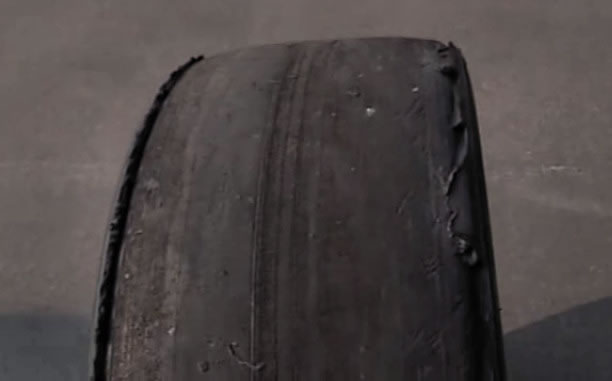
If you see tire like this after drifting session, that mean that tire was used in proper way!
You can't drift properly in a front wheel drive car - you can oversteer temporarily, but it's impossible to sustain a drift correctly without rear or four wheel drive. Four wheel drive car is better, but still not good enough for competition.
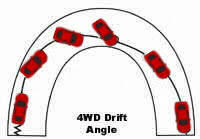 |
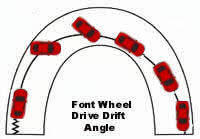 |
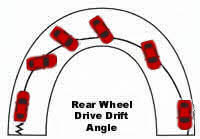 |
Drifting is grown into a competitive driving technique that over time has emerged as a sport in its own. Requiring a high level of skill on the part of the driver, drifting is often employed in high speed competitions around the world, including the D1 Grand Prix in Japan.
Theory:
A tire grips the road up to a maximum point of adhesion, when this point is exceeded the tire will start to slide until adhesion is restored. So finding and pushing just beyond the point of adhesion is the name of the game.
Once a car begins to drift driver control comes into play - the exact amount of turn on the steering wheel towards the direction of travel to catch and control the drift.
At precisely the right moment you have to catch the drift with a measure of opposite lock and use the throttle and steering to control the drift - a sustained drift on a straight is called 'drift lock'.
A car is said to be drifting when the rear slip angle is greater than the front slip angle prior to the corner apex, and the front wheels are pointing in the opposite direction to the turn (e.g. car is turning left, wheels are pointed right or vice versa), and the driver is controlling these factors. Once the back starts to come round you need to act quickly and smartly. Keep the power on and quickly counter-steer in the desired direction of travel, and balance the throttle to alter the attitude of the car. To sustain the drift you need to keep the power on to keep the rear wheels spinning - about 80% throttle is the rule of thumb (although you'll need less in slippery conditions). If the back comes round too far, gently ease off the throttle and apply additional steering lock to correct the slide. If you're finding it hard to keep the slide going, you may need to use more power or take the corner slightly faster.
Finishing the drift and getting the car straight again can be tricky - if you end the drift too quickly you might find the car starts to oversteer in the opposite direction, leading to 'fishtailing' and a pendulum effect which can be hard to control. The trick is to ease off the power and turn the steering rapidly and decisively back to the straight ahead position. Don't let the steering run through your hands as this won't give you the control you need.
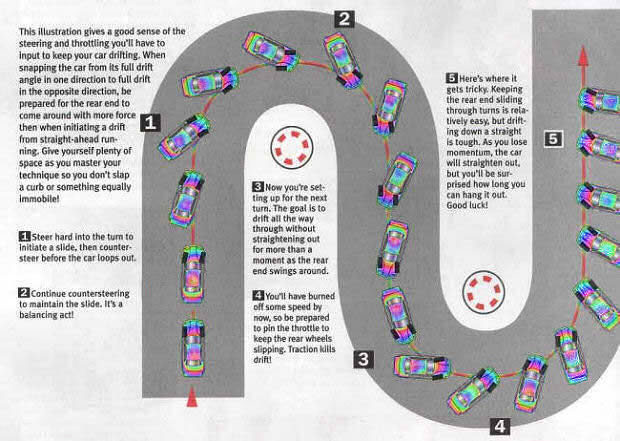
Drifting has been part of the professional racing sport for a number of years, commonly employed in such motorsport competitions as rally racing, dirt track racing, and national competitions such as the Grand Prix.
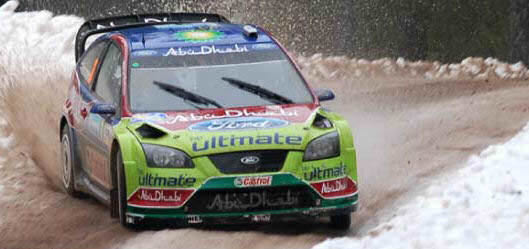
Scandinavian flick
Drifting is a procedure that can be advantageous in many situations. A competent professional driver may use drifting to gain an advantage on a turn, as well as turn the car sideways in a manner that can prevent another car from being able to make a direct pass. A lot of the success of using drifting depends on the ability of the driver to control the maneuver, so that the drifting does not degenerate into uncontrolled fishtailing, a situation that places the driver and other competitors in a great deal of danger.
Since the 1970s, drifting has gained a great deal of attention as a competitive sport in its own. Drivers are often judged on a number of criteria by a group of experts.
Usually, competition drift cars are light to moderate weight rear-wheel-drive coupes and sedans. In Japan and worldwide, the most common drift machines are the Nissan Silvia/180SX/200SX, Toyota AE86, Mazda RX-7, Nissan A31 Cefiro, Nissan C33 Laurel, Nissan Skyline (RWD versions), Nissan 350Z, Toyota Altezza, Toyota Chaser, Toyota Mark II, Toyota MZ20 Soarer, Honda S2000, Toyota Supra (MKIV), Ford Mustang and Mazda Miata. US drift competitions use the same cars, plus Chrysler LLC's Dodge Charger, Pontiac Solstice, Holden Commodore, and Holden Monaro. Drifters in other countries often use local favorites, such as the Jaguar Cars, Vauxhall Motors (UK and Ireland), BMW 3 Series (other parts of Europe), Mercedes-Benz, Porsche, and Alfa Romeo 75. As you can see, the vehicles used in these competitions are all rear-wheel drive cars with good power delivery, which can help drivers to maintain an equitable speed while remaining in a sideways position for an extended period.
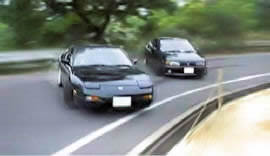
The elements that are often part of the judging include speed, angle, line, and show. In various parts of the world, the impact of each of these elements on the final score varies slightly. In the competition drive, there are generally two sessions, with the first session more or less qualifying who will be allowed to compete in the final session. In some drifting competitions, the individual competitor is not only judged on his or her technique, but also the angle, line, and speed in comparison to the lead car in the competition.
Professional drifting competitions take place under controlled conditions. However, there are amateur drifting enthusiasts that sometimes attempt to replicate the process on public roads. This has emerged as a problem in several countries, most notably Saudi Arabia and Japan.
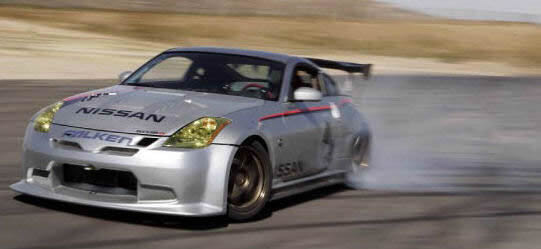
Drifting Techniques
Before all, learn proper race shifting to get your car into the right gear for drifting. Includes double clutch shifting and heel and toe shifting.
Power Over
This is performed when entering a corner and using full throttle to produce heavy oversteer through the turn. You need a lot of horsepower to make this happen.
E-Brake ( hand brake) Drift
This technique is very basic, pull the E-Brake or hand brake to induce rear traction loss and balance drift through steering and throttle play. This can also be used to correct errors or fine tune drift angles. Main drift technique used in Forward Wheel Drive vehicles.
Clutch Kick
This is performed by depressing the clutch pedal on approach or during a mild drift, then the clutch is "popped-up" to give a sudden jolt through the driveline to upset rear traction.
Shift Lock Drift
This is performed by letting the revs drop on downshift into a corner and then releasing the clutch fast to put stress on the driveline to slow the rear tires inducing oversteer. This is like pulling the E-brake through a turn, but this should be performed on wet ground to minimize damage to the driveline.
Dirt Drop Drift
This is performed by dropping the rear tires off the road into the dirt to maintain or gain drift angle without losing power or speed and to set up for the next turn. This technique is very useful for low horsepower cars. Do not attempt this technique at the Drift Session or you will lose precious points.
Feint Drift
This is performed by rocking the car towards the outside of a turn and then using the rebound of grip to throw the car into the normal cornering direction. This is heavy rally racing technique used to change vehicle attitudes during cornering.
Jump Drift
In this technique the rear tire on the inside of a turn or apex is bounced over a curb to lose traction resulting in oversteer. Do not attempt this technique at the Drift Session or you will lose precious points.
Braking Drift
This is performed by trail braking into a corner. Loss of grip is obtained and then balanced through steering and throttle motions. This is mainly for medium to low speed corners.
Kansei Drift
This is performed at race speeds. When entering a high speed corner a driver lifts his foot off the throttle very fast to induce a mild oversteer and then balances the drift through steering and throttle motions. The car that is being used for this style of drift should be a neutral balanced car therefore the oversteer will induce itself. If the car plows through any turn this technique will not work.
Long Slide Drift
This is done by pulling the E-brake through a strait to start a high angel drift and to hold this to set up for the turn ahead. This technique can only be done at high speed.
Swaying Drift (Choku-Dori)
This is a slow side-to-side faint like drift where the rear end sways back and forth down a strait. Noting to do with Scandinavian flick.
Scandinavian flick
The Scandinavian flick is a technique used frequently in rallying, a method of breaking traction at the rear wheels of a car on loose surfaces in order to turn a tight corner rapidly. The tightest corners and hairpins usually require the use of a handbrake turn, but the flick can be used in conjunction with, or without the handbrake. The name arose from the Finnish and Swedish rally racers of the 1960s who widely used it with great success.
1. Set yourself up for the corner slightly to the outside of center. You don't want to take the racing line here as you need to have room on the outside of the corner. Get all of your braking out of the way in a straight line and ease off the brakes when your cornering speed is reached.
2. Turn briefly towards the outside of the corner, using trail braking if necessary (feathering the brake into the corner) to reduce any understeer you might experience. You don't want to take a lot of time over this motion, just enough to create a weight transfer to the inside wheels.
3. Almost immediately turn in sharply in the correct direction of the corner. When done properly, the reverse in weight transfer to the outside wheels should unsettle the rear of the car enough to break traction.
4. The back of the car will start to come round - this tightens the radius of the turn and thus allows quite tight corners to be taken at speed. Counter steer if necessary to keep the car heading in the desired direction. Once you're past the apex of the corner, gradually reduce the amount of steering lock. Once you have completed the corner, apply progressive throttle to accelerate out of the corner.
Remember:
"If you trying a drifting and you're out of control you're a moron. Drifting is all about staying IN control and throwing some radical angles."
To have a complete picture of performance driving, take a look at Corners, Setup, Traction circle, Using tires, Left foot braking, braking, advanced braking, WRC braking technique, Slipstreaming, cornering, shifting, Heel and toe driving technique and steering technique articles
Back to the top of the page






